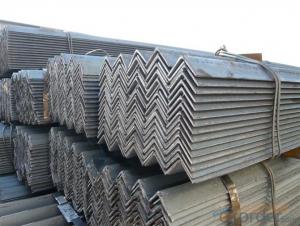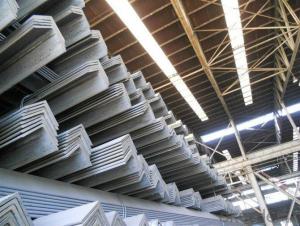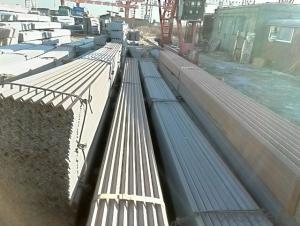2015 Hot Rolled Angle Steel in Construction
- Loading Port:
- Tianjin
- Payment Terms:
- TT OR LC
- Min Order Qty:
- 25 m.t.
- Supply Capability:
- 20000 m.t./month
OKorder Service Pledge
OKorder Financial Service
You Might Also Like
Specification
OKorder is offering high quality Hot Rolled Steel Angle at great prices with worldwide shipping. Our supplier is a world-class manufacturer of steel, with our products utilized the world over. OKorder annually supplies products to European, North American and Asian markets. We provide quotations within 24 hours of receiving an inquiry and guarantee competitive prices.
Product Applications:
Hot Rolled Steel Angles are ideal for structural applications and are widely used in the construction of buildings and bridges, and the manufacturing, petrochemical, and transportation industries.
Product Advantages:
OKorder's Steel Angles are durable, strong, and resist corrosion.
Main Product Features:
· Premium quality
· Prompt delivery & seaworthy packing (30 days after receiving deposit)
· Corrosion resistance
· Can be recycled and reused
· Mill test certification
· Professional Service
· Competitive pricing
Product Specifications:
Manufacture: Hot rolled
Grade: Q195 – 235
Certificates: ISO, SGS, BV, CIQ
Length: 6m – 12m, as per customer request
Packaging: Export packing, nude packing, bundled
Sizes: 25mm-250mm | ||
a*t | ||
25*2.5-4.0 | 70*6.0-9.0 | 130*9.0-15 |
30*2.5-6.6 | 75*6.0-9.0 | 140*10-14 |
36*3.0-5.0 | 80*5.0-10 | 150*10-20 |
38*2.3-6.0 | 90*7.0-10 | 160*10-16 |
40*3.0-5.0 | 100*6.0-12 | 175*12-15 |
45*4.0-6.0 | 110*8.0-10 | 180*12-18 |
50*4.0-6.0 | 120*6.0-15 | 200*14-25 |
60*4.0-8.0 | 125*8.0-14 | 250*25 |
FAQ:
Q1: Why buy Materials & Equipment from OKorder.com?
A1: All products offered byOKorder.com are carefully selected from China's most reliable manufacturing enterprises. Through its ISO certifications, OKorder.com adheres to the highest standards and a commitment to supply chain safety and customer satisfaction.
Q2: How do we guarantee the quality of our products?
A2: We have established an advanced quality management system which conducts strict quality tests at every step, from raw materials to the final product. At the same time, we provide extensive follow-up service assurances as required.
Q3: How soon can we receive the product after purchase?
A3: Within three days of placing an order, we will begin production. The specific shipping date is dependent upon international and government factors, but is typically 7 to 10 workdays.
Alloy No | Grade | Element (%) | ||||
C | Mn | S | P | Si | ||
Q235 | B | 0.12—0.20 | 0.3—0.7 | ≤0.045 | ≤0.045 | ≤0.3 |
Alloy No | Grade | Yielding strength point( Mpa) | ||||
Thickness (mm) | ||||||
≤16 | >16--40 | >40--60 | >60--100 | |||
≥ | ||||||
Q235 | B | 235 | 225 | 215 | 205 | |
Alloy No | Grade | Tensile strength (Mpa) | Elongation after fracture (%) | |||
Thickness (mm) | ||||||
≤16 | >16--40 | >40--60 | >60--100 | |||
≥ | ||||||
Q235 | B | 375--500 | 26 | 25 | 24 | 23 |
Images:


- Q: How do you cut steel angles?
- Steel angles can be cut using various methods such as using a metal-cutting saw, an angle grinder with a cutting disc, or a plasma cutter. It is important to ensure proper safety precautions, use appropriate tools, and follow the manufacturer's instructions for the specific cutting method being used.
- Q: How do you connect steel angles together?
- There are several ways to connect steel angles together depending on the specific application and load requirements. Here are a few common methods: 1. Welding: The most common and effective method is to weld the steel angles together. This creates a strong and permanent connection. It is important to ensure proper welding techniques are followed to maintain the integrity and strength of the joint. 2. Bolting: Another method is to use bolts and nuts to connect the steel angles. This allows for easy disassembly and reassembly if required. It is important to use the correct size and grade of bolts to ensure the connection can withstand the intended loads. 3. Riveting: Rivets can also be used to connect steel angles together. This method provides a strong and permanent connection, but it requires specialized tools and expertise to properly install the rivets. 4. Adhesive bonding: In some cases, adhesive bonding techniques can be used to connect steel angles together. This method is usually used in conjunction with other fastening methods, such as welding or bolting, to provide additional strength and stability. When choosing the method to connect steel angles, it is important to consider factors such as the load requirements, environmental conditions, and expected lifespan of the structure. Consulting with a structural engineer or a professional in the field is recommended to ensure the best connection method is chosen for your specific application.
- Q: Can steel angles be used for reinforcing concrete structures?
- Yes, steel angles can be used for reinforcing concrete structures. Steel angles provide additional strength and stability to concrete structures, increasing their load-bearing capacity and resistance to bending and shearing forces. These angles are typically used to reinforce corners, edges, and joints, helping to prevent cracking and enhance the overall durability of the structure.
- Q: How are steel angles made?
- The production of steel angles involves a process known as hot rolling, where steel angles are created. The process begins by heating a large steel billet in a furnace at extremely high temperatures until it becomes malleable. Subsequently, the heated billet is passed through a series of rollers that shape it into the desired angle profile. These rollers possess grooves that correspond to the desired angle dimensions, allowing the steel to gradually take on the shape of an angle. As the steel billet is fed through the rollers, it undergoes compression and elongation, resulting in a longer and thinner piece of steel with the desired angle shape. This process serves to enhance the mechanical properties of the steel, increasing its strength and durability. Once the steel angle has been formed, it proceeds through a cooling process to stabilize its shape and prevent any deformations. Subsequently, it is cut to the necessary length and undergoes various finishing processes, such as straightening, surface treatment, and inspection, to ensure its quality and dimensional accuracy. In summary, the production of steel angles encompasses a series of processes, including heating, rolling, cooling, cutting, and finishing. These processes are meticulously designed to manufacture high-quality steel angles with precise shapes, suitable for a wide range of construction and manufacturing applications.
- Q: What is the maximum load capacity for a steel angle beam?
- The maximum load capacity for a steel angle beam depends on various factors such as the size and dimensions of the beam, the grade of steel used, and the specific application or intended use. Steel angle beams are commonly used in construction and structural applications for supporting loads, but the exact maximum load capacity can vary. It is important to consult engineering specifications, structural design codes, or consult with a structural engineer to determine the specific maximum load capacity for a steel angle beam in a particular scenario.
- Q: What are the load-bearing capacities of different steel angle sizes?
- The load-bearing capacities of different steel angle sizes vary depending on factors such as the thickness of the steel, the length of the angle, and the type of load being applied. Generally, larger and thicker steel angles have higher load-bearing capacities. It is recommended to consult engineering tables, codes, or a structural engineer to determine the specific load-bearing capacity for a particular steel angle size.
- Q: How do steel angles contribute to energy-efficient construction?
- Steel angles contribute to energy-efficient construction in several ways. First, they provide structural support, ensuring that the building is strong and stable. This allows for the effective use of insulation materials, reducing heat loss or gain through walls and floors. Additionally, steel angles can be used to create efficient framing systems, minimizing thermal bridges and enhancing the building's overall energy performance. Furthermore, steel is a durable material that requires minimal maintenance, reducing the energy and resources needed for repairs and replacements. Overall, steel angles play a crucial role in energy-efficient construction by optimizing insulation, reducing thermal bridging, and enhancing the overall sustainability of the building.
- Q: Can steel angles be used in the construction of solar panel support structures?
- Indeed, the utilization of steel angles is viable for the establishment of support structures for solar panels. The construction sector frequently utilizes steel angles owing to their robustness and endurance. They offer exceptional support and stability, which are vital aspects for solar panel installations. The fusion or fastening of steel angles can be effortlessly accomplished to form sturdy and inflexible structures capable of enduring the weight of solar panels and the diverse environmental conditions, including wind and snow loads, to which they may be exposed. Furthermore, steel angles can be tailored to meet the precise design prerequisites of the support structure for solar panels, rendering them a versatile option for construction ventures.
- Q: What are the considerations for selecting the appropriate steel angle length?
- When choosing the right length for a steel angle, there are several factors to consider. Firstly, the intended purpose of the steel angle is crucial. The length should be determined based on the specific application it will be used for. For instance, if it is being used for structural purposes, the length should be chosen to provide the necessary strength and support for the intended load. Secondly, the size and dimensions of the project or structure should be taken into account. The length of the steel angle should be determined based on the overall size and scale of the project. This includes considering the height, width, and overall dimensions of the structure where the steel angle will be used. Moreover, it is important to consider the weight and load-bearing capacity of the steel angle. The length should be selected to ensure that it can support the expected load without bending or buckling under pressure. Consulting engineering specifications and load calculations is crucial to determine the appropriate length based on the anticipated weight and load requirements. Additionally, the availability and cost of the steel angle should be considered. Different lengths may have varying availability and cost implications. It is important to assess the availability and cost of different lengths to determine the most suitable option that meets both budgetary and project requirements. Lastly, consulting relevant building codes, regulations, and industry standards is essential when choosing the appropriate steel angle length. These guidelines provide specific requirements and recommendations for structural elements, including steel angles. Complying with these standards ensures the safety and integrity of the structure. In conclusion, the factors to consider when selecting the appropriate steel angle length include the intended use, size and dimensions of the project, weight and load-bearing capacity, availability and cost, as well as compliance with building codes and industry standards. By taking these factors into account, one can ensure the selection of a steel angle length that is suitable for the specific application and requirements.
- Q: Are steel angles suitable for high-temperature applications?
- High-temperature applications are not suitable for steel angles. Carbon steel, typically used to make steel angles, experiences a decline in strength and structural integrity when exposed to elevated temperatures. Thermal expansion, a phenomenon that occurs in carbon steel at high temperatures, causes it to expand and weaken. Consequently, steel angles may deform and fail under these conditions. To ensure stability and strength in high-temperature applications, it is advisable to use materials like stainless steel or alloys with superior heat resistance, such as Inconel or Hastelloy. These alternative materials can endure higher temperatures without experiencing significant loss in strength or structural stability.
Send your message to us
2015 Hot Rolled Angle Steel in Construction
- Loading Port:
- Tianjin
- Payment Terms:
- TT OR LC
- Min Order Qty:
- 25 m.t.
- Supply Capability:
- 20000 m.t./month
OKorder Service Pledge
OKorder Financial Service
Similar products
Hot products
Hot Searches
Related keywords




























